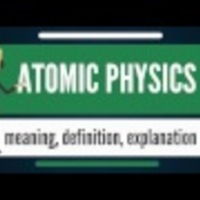Atomic Physics
Dublin Core
Title
Subject
Description
Atomic physics is the field of physics that studies atoms as an isolated system of electrons and an atomic nucleus. It is primarily concerned with the arrangement of electrons around the nucleus and the processes by which these arrangements change. This comprises ions, neutral atoms and, unless otherwise stated, it can be assumed that the term atom includes ions.
The term atomic physics can be associated with nuclear power and nuclear weapons, due to the synonymous use of atomic and nuclear in standard English. Physicists distinguish between atomic physics — which deals with the atom as a system consisting of a nucleus and electrons — and nuclear physics, which considers atomic nuclei alone.
As with many scientific fields, strict delineation can be highly contrived and atomic physics is often considered in the wider context of atomic, molecular, and optical physics. Physics research groups are usually so classified.
Atomic physics primarily considers atoms in isolation. Atomic models will consist of a single nucleus that may be surrounded by one or more bound electrons. It is not concerned with the formation of molecules (although much of the physics is identical), nor does it examine atoms in a solid state as condensed matter. It is concerned with processes such as ionization and excitation by photons or collisions with atomic particles.
While modelling atoms in isolation may not seem realistic, if one considers atoms in a gas or plasma then the time-scales for atom-atom interactions are huge in comparison to the atomic processes that are generally considered. This means that the individual atoms can be treated as if each were in isolation, as the vast majority of the time they are. By this consideration atomic physics provides the underlying theory in plasma physics and atmospheric physics, even though both deal with very large numbers of atoms.
Input by : Rahmah Agustira
The term atomic physics can be associated with nuclear power and nuclear weapons, due to the synonymous use of atomic and nuclear in standard English. Physicists distinguish between atomic physics — which deals with the atom as a system consisting of a nucleus and electrons — and nuclear physics, which considers atomic nuclei alone.
As with many scientific fields, strict delineation can be highly contrived and atomic physics is often considered in the wider context of atomic, molecular, and optical physics. Physics research groups are usually so classified.
Atomic physics primarily considers atoms in isolation. Atomic models will consist of a single nucleus that may be surrounded by one or more bound electrons. It is not concerned with the formation of molecules (although much of the physics is identical), nor does it examine atoms in a solid state as condensed matter. It is concerned with processes such as ionization and excitation by photons or collisions with atomic particles.
While modelling atoms in isolation may not seem realistic, if one considers atoms in a gas or plasma then the time-scales for atom-atom interactions are huge in comparison to the atomic processes that are generally considered. This means that the individual atoms can be treated as if each were in isolation, as the vast majority of the time they are. By this consideration atomic physics provides the underlying theory in plasma physics and atmospheric physics, even though both deal with very large numbers of atoms.
Input by : Rahmah Agustira
Source
http://youtu.be/i9l1nb3IF5U
Publisher
Date
2017-04-12T00:00:05.000Z
Contributor
Rahmah Agustira
Rights
Creative Commons License
This video represents licensed content on YouTube, meaning that the content has been claimed by a YouTube content partner.
This video represents licensed content on YouTube, meaning that the content has been claimed by a YouTube content partner.
Moving Image Item Type Metadata
Imported Thumbnail
https://i.ytimg.com/vi/i9l1nb3IF5U/default.jpg
Files
Collection
Citation
“Atomic Physics,” Open Educational Resources (OER) , accessed September 16, 2025, https://oer.uinsyahada.ac.id/items/show/42.


